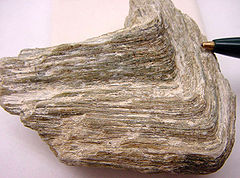Enstatite
| Enstatite | |
|---|---|
 |
|
| General | |
| Category | Inosilicate |
|
Formula (repeating unit) |
MgSiO3 |
| Strunz classification | 9.DA.05 |
| Crystal system | Orthorhombic |
| Crystal class | Dipyramidal (mmm) H-M symbol: (2/m 2/m 2/m) |
| Space group | Pbca |
| Unit cell | a = 18.23, b = 8.84 c = 5.19 [Å]; Z = 8 |
| Identification | |
| Color | White, grey, green, yellow or brown - colorless in thin section. |
| Crystal habit | Prismatic crystals, commonly lamellar, fibrous, or massive |
| Twinning | Simple and lamellar on [100] |
| Cleavage | Good/distinct on [210] |
| Fracture | Uneven |
| Tenacity | Brittle |
| Mohs scale hardness | 5 to 6 |
| Luster | Vitreous, pearly on cleavage |
| Streak | Gray |
| Diaphaneity | Translucent to opaque |
| Specific gravity | 3.2–3.3 |
| Optical properties | Biaxial (+) |
| Refractive index | nα = 1.650–1.668; nβ = 1.652–1.673; nγ = 1.659–1.679 |
| Birefringence | δ = 0.009–0.011 |
| Pleochroism | Pale green to pale orange |
| 2V angle | 55–90° |
| References | |
Enstatite is a mineral; the magnesium endmember of the pyroxene silicate mineral series enstatite (MgSiO3) - ferrosilite (FeSiO3). The magnesium rich members of the solid solution series are common rock-forming minerals found in igneous and metamorphic rocks. The intermediate composition, (Mg,Fe)SiO3, has historically been known as hypersthene, although this name has been formally abandoned and replaced by orthopyroxene. When determined petrographically or chemically the composition is given as relative proportions of enstatite (En) and ferrosilite (Fs) (e.g., En80Fs20).
Most natural crystals are orthorhombic (space group Pbca) although three polymorphs are known. The high temperature, low pressure polymorphs are protoenstatite and protoferrosilite (also orthorhombic, space group Pbcn) while the low temperature forms, clinoenstatite and clinoferrosilite, are monoclinic (space group P21/c).
Weathered enstatite with a small amount of iron takes on a submetallic luster and a bronze-like color. This material is termed bronzite, although it is more correctly called altered enstatite.
Bronzite and hypersthene were known long before enstatite, which was first described by G. A. Kenngott in 1855.
An emerald-green variety of enstatite is called chrome-enstatite and is cut as a gemstone. The green color is caused by traces of chromium, hence the varietal name. In addition, bronzite is also sometimes used as a gemstone.
...
Wikipedia
